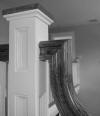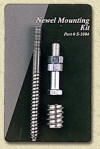
Triangular blocks of wood attached with construction adhesive and screws to the underside of the stairs at the junction where the riser meets the tread and/or where the stringer meets a riser or tread.
Balusters

Small vertical members that are used to support a handrail.
Balustrade

The entire assembly that supports the handrail. It consists of newels, balusters and the handrail.
Bracketed Stringer

A stringer that is not notched but has a special metal bracket attached to the inside in order to support the step treads.
Cleat Stringer

A stringer that is not notched but has wood cleats screwed to the inside to support the step treads.
Closed Riser

A style of staircase which uses material to hide the stringers between the treads.
Dado Stringer
Image Not Available
A stringer that has channels mortised on the inside faces to accept the stair treads and /or risers.
Dovetailed Baluster
Image Not Available
Balusters that are attached to stair treads using a dovetail joint. This is an older method of construction.
Filleted Balustrade
Image Not Available
A balustrade consisting of spaces filled with short pieces of wood between balusters.
Finial

An ornamental projection on a newel as an example.
Folding Attic Stairs

Stairs that mount hidden in a ceiling panel and conveniently pull down to allow access to the attic.
Gooseneck

The upper most section of a curved staircase fitting. Usually used to describe the end piece of a railing.
Handrail

The part of either a balustrade or wall rail that is grasped by the hand.

A 3/4 inch thick piece of plywood used on interior stairs as a method to secure the stringers to the upper floor joists.

The vertical distance between the bottom most material of a staircase opening and the highest stair tread.

A method of staircase construction where the stringers have tapered mortises routed into the face of the stringers. Treads and risers fit into the mortises and are secured with wedges.

